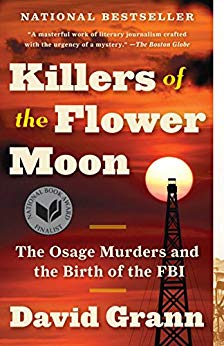

This article is an excerpt from the Shortform summary of "Killers of the Flower Moon" by David Grann. Shortform has the world's best summaries of books you should be reading.
Like this article? Sign up for a free trial here .
Who was Anna Brown? How was she touched by the Osage murder conspiracy?
Anna Brown, a young Osage woman, was the first known victim of the Osage Reign of Terror. Her close family members also fell victim to the evil plot. FBI investigator Tom White connected the murders and ultimately brought the killers to justice.
Keep reading to learn about the death of Anna Brown and how it was only one piece of the puzzle.
Anna Brown: The First Victim
Every April, millions of tiny flowers burst into life across the vast plains of Osage County, Oklahoma. But their beauty is short-lived. In May, larger flowers bloom, killing the smaller ones by choking out their access to life-giving sun and water. This is why the Osage call May “the time of the flower-killing moon.” In 1921, May was to signal the start of a far more sinister season of death.
On May 27, 1921, the partially decomposed body of a 25-year-old Osage woman named Anna Brown was discovered in a ravine in Osage County, Oklahoma, dead from a bullet to the back of the head. Anna Brown would be merely one of the first victims in a five-year-long Reign of Terror that would run from 1921-1926 and claim the lives of dozens (and possibly hundreds) of Osage men, women, and children.
Anna Brown’s immediate family included her sisters, Mollie Burkhart and Rita Smith, and her mother, Elizabeth Kyle. Mollie was married to a white man named Ernest Burkhardt, a native of Texas who had moved to Osage County as a young man. Rita and Anna had also married white men.
(Shortform note: In this NPR interview, Killers of the Flower Moon author David Grann explains that intermarriage between whites and Osage had become quite common by the early 20th century. Many white people from states bordering Oklahoma had been drawn to the area by the oil boom and the opportunity to get rich—by either striking oil or marrying an Osage.)
Anna Brown had been a vivacious, outgoing young woman. In the days before her disappearance, Anna’s family had been concerned about her behavior—she had been staying out late at night at speakeasies, often in the company of Bryan Burkhart, the brother of her sister Mollie’s husband. Anna had been missing for three days, immediately sparking her family’s worst fears. They were no strangers to loss—just a few years before, a younger sister named Minnie had died of a mysterious and unexplained wasting illness.
A Larger Conspiracy
But Anna Brown’s murder was to be just the beginning. About a week after her body was discovered, another Osage victim was found near an oil rig. This time, the corpse belonged to a man named Charles Whitehorn, who had been missing for about two weeks. Whitehorn was a well-known and popular figure in Osage County, married to a half-white, half-Cheyenne woman. Like Anna Brown, he had been shot in the head—and the bullets appeared to be the same kind as the ones that had killed Anna Brown.
The execution-style murders of two Osage, coming so quickly on the heels of one another, became a prominent story in the local news, as speculation began to mount about who could be responsible. The similar method of killing suggested a link between the two murders, as did their proximity in space and time.
Because she spoke English and was married to a white man, Mollie became the family’s natural liaison with the white authorities. But this was also due to the fact that she wasn’t married to just any white man. Her husband, Ernest Burkhart, was the nephew of William Hale, one of the most prominent figures in Osage County.
Hale was a widely respected businessman and influential force in the county, having made his fortune in the cattle business. Known as the “King of the Osage Hills,” Hale’s business interests were firmly entrenched throughout the county. He had powerful political connections and was even a reserve deputy sheriff in the town of Fairfax. The county prosecutor himself owed his election to Hale.
In an era when many white authority figures used their status to exploit and abuse the Osage, Hale positioned himself as a benevolent, if somewhat paternal, figure. His philanthropy had supported the establishment of charities, schools, and hospitals for the Osage, and he vowed to Mollie and her mother that he would see justice done for Anna Brown.
By July 1921, the local authorities wrapped up the investigation, concluding that Anna was murdered by “parties unknown.” They had surrendered the quest for justice for Anna. And that same month, another tragedy befell Mollie Brown when her mother, Lizzie, died from her wasting illness, so similar to how Minnie had died a few years before—and to how many other healthy Osage seemed to have died of unexplained wasting sicknesses in recent months.
Bill Smith, a white man and the husband of Mollie’s sister, Rita, found the circumstances of Lizzie’s death to be highly suspicious. He began to believe that she and other Osage had been deliberately poisoned and that her death was linked to those of Anna Brown and Charles Whitehorn.
Tom White headed to the Oklahoma City field office in 1925 to lead the Osage investigation. Upon examining the case, he saw patterns in the killings: all were of wealthy Osage or their benefactors, and three (Anna Brown, Rita Smith, and, their mother, Lizzie) were direct blood relatives.
Investigation and Prosecution
Tom methodically ruled out many of the suspects up to that point, including Anna Brown’s ex-husband, by corroborating their alibis. One witness, a young Kaw Indian woman, claimed that another woman named Rose Osage had told her that she’d murdered Anna Brown as revenge for attempting to seduce her boyfriend, a man named Joe Allen. According to the Kaw Indian’s signed statement, Rose and Joe had shot Anna in the back of the head and then dragged the body to the ravine where it was discovered.
Ernest Burkhart, the husband of Anna Brown’s sister, Mollie, finally, gave key information about the murder of Anna Brown. He said that the mysterious “third man” spotted with Anna and his brother, Bryan Burkhart, on the last night Anna was seen alive was Kelsie Morrison—a man who was later engaged by the Bureau to work as an undercover operative. Ernest said that Morrison was, in fact, the man who had put the bullet in Anna Brown. All the awful pieces of the puzzle were finally coming together.
So many prominent members of the white community had blood on their hands—business leaders like Hale; doctors like the Shoun brothers; merchants like Scott Mathis, owner of the Big Hill Trading Company and guardian of Anna Brown’s estate; bankers like H.G. Burt; not to mention attorneys, politicians, law enforcement officials, and judges.
Anna Brown was a young woman whose tragic death was a part of a campaign to steal the wealth of the Osage people. Anna Brown’s killers were brought to justice, but her death remains an incredible tragedy.

———End of Preview———
Like what you just read? Read the rest of the world's best summary of David Grann's "Killers of the Flower Moon" at Shortform .
Here's what you'll find in our full Killers of the Flower Moon summary :
- How the Osage tribe had vast oil wealth, but had it seized by their murderous neighbors
- The brutal and unresolved murders of Osage Native Americans
- The complicated history of the FBI in profiting from the Osage murders






